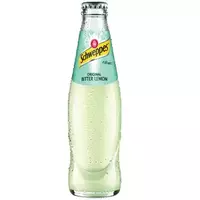Bitter lemon

Balms and bitters are two related drinks that have a different composition. Both are based on extracts of healing herbs. Despite this, bitters are much simpler and contain fewer components. In addition, if the balm originally arose as a medicine, then bitter is an alcoholic drink. The first mention of it goes back to 153
3. Bitter was produced in France by local monks.
There are variations among bitters that are most popular. One of them is the bitter lemon. It is carbonated and non-alcoholic. In addition, at the production stage, the bitter is seasoned with lemon and quinine. It is the latter that gives it a peculiar bitter taste. Initially, the drink appeared in North America and was available there under several trade names at once. Its central supplier these days is Schweppes. The stamp was introduced by her back in 195
7.
The bitter lemon has a characteristic golden hue. This became possible by adding natural lemon juice to it. As a rule, it is sold in bottles, whose volume does not exceed 0. 5 liters.
Options for eating lemon bitter
The soft drink tastes good with a barely noticeable lemon finish. However, solo it is used quite rarely. It is most often used to make cocktails. An experienced bartender will be able to offer you about 10 of them. The bitter lemon is great with gin, white vermouth and melon liqueur. As for strong alcoholic beverages, different varieties of vodka are suitable.
Visiting a specialist cocktail bar, you can try the following drinks: bitter melon, bianco bitter lemon, hallelujah, courant bitter lemon and some others. Most have a refreshing taste and are perfect for a warm summer evening.
Benefits and harms of lemon bitter
You should not abuse the bitter, like any other drink. Otherwise, you may face the consequences of individual intolerance. Moderate consumption of bitter has been shown to have a beneficial effect on the circulatory system. Add to this improved well-being and high spirits.
bitter lemon kCal
The energy value of lemon bitter (Ratio of proteins, fats, carbohydrates - ju):
Proteins: g (~ 0 kCal)
Fats: g (~ 0 kCal)
Carbohydrates: g (~ 0 kCal)
 Español
Español Français
Français Português
Português Русский
Русский 简体中文
简体中文 繁體中文
繁體中文 日本語
日本語 한국어
한국어 العربية
العربية Türkçe
Türkçe Қазақ
Қазақ Deutsch
Deutsch Italiano
Italiano Українська
Українська
